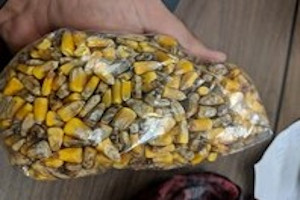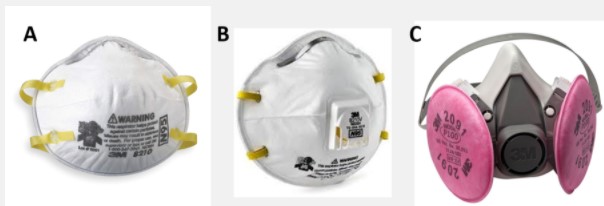By Pierce Paul and Felipe Dalla Lana da Silva et.al
Harvesting, Sampling, and Testing: This year, slow grain dry-down, delayed harvest, and late-season rainfall have led to fairly high levels of one or more ear rots (Gibberella, Fusarium, Diplodia and Trichoderma) in some corn fields. Of these, Gibberella ear rot (GER) has been the most frequently reported and is the ear rot of greatest concerns since grain harvested from GER-affected fields will be contaminated with vomitoxin and other mycotoxins. One of the primary consequences of GER is vomitoxin contamination of dried distiller’s grains with solubles (DDGS), a nutrient-rich co-product of ethanol production that is commonly sold as an ingredient for animal feed. Vomitoxin is not destroyed during ethanol production nor is it removed in the ethanol fraction, but rather becomes concentrated in the grain fraction. This leads to three-fold higher levels of the toxin in DDGS over the levels found in the original grain. Consequently, ethanol plants may reject GER-affect grain with high levels of vomitoxin.
As we mentioned in our factsheet (https://ohioline.osu.edu/factsheet/plpath-cer-04), moldy kernels are usually not evenly distributed in a grain lot, and as a result, toxin-contaminated grain are usually found in pockets (hot spots). Consequently, poor sampling and/or testing technique may lead to incorrect estimation of vomitoxin in the grain lot. For instance, a sample pulled from a hot spot may lead to an overestimated of the overall level of contamination on the load. Prior to testing, producers (or their agents) may request a second sample be drawn if they feel the first sample was not representative of the entire lot. Following vomitoxin testing, producers/agents have the right to reject the commodity testers’ results and ask the handler to send the sample to a federally licensed grain inspector for a re-test. Refer to Ohio Code 926.31 for details.

Moldy Corn Sample
Severely diseased and toxin contaminated grain are usually smaller than healthy grain and covered with fungal mycelium (mold). Compared to healthy grain, diseased grain break easily during harvest, transport, and other forms of grain handling, increasing the number of fine particles and the amount of dust in the grain lot. Fields with ear rot problems should be harvested as soon as possible and handled separately from healthy field, even if it means harvesting those field at a higher-than-usual moisture content. Adjust the combine to minimize damage to the grain and increasing the fan speed will help to remove lightweight grain and dust particles, and as a result, reduce the level of mycotoxin in the grain lot. Once harvested, grain should be dried down to below 15% moisture and storage in a clean dry bin.
Respiratory Alert – Harvesting and handling moldy grain may expose farmers to mycotoxin and other moldy conditions in the grain dust. Dust in grain harvested from GER-affected fields contain a mixture of tiny pieces of grain, husks, and cobs, all of which may be contaminated with vomitoxin, as well as pieces of fungal mycelium (mold). In fact, husks and cobs are usually more contaminated with mycotoxins than the grain. Breathing grain dust can have adverse effects on the human respiratory system. When the dust is also suspect of mycotoxins, it is especially necessary to take precautions.
Wearing a disposable, 2-strap N95 mask (respirator) helps protect the worker from breathing in dusty, moldy and toxic substances (Figures A and B). This type of personal protection equipment will filter out at least 95% of the dust and mold in the air. The 1-strap mask does not have this level of protection, and is basically worthless in agricultural environments.
The COVID-19 pandemic has made it difficult to purchase the recommended respirators for agricultural work. The suppliers have increased manufacturing of these items, however some local outlets are still limited in their product availability due to an increase need to service medical personnel.
If disposable masks are not available, consider a reusable quarter face mask with interchangeable cartridges (Figure C). P100 filters may be more readily accessible for online purchases. Quarter masks, with replaceable cartridges, may also be more economical in the long term because of their multi-functional applications in agricultural settings.

Respirator products: A) disposable N95, B) disposable N95 with exhalation valve; C) reusable quarter mask with P100 air cartridge.
How to wear respirators correctly
Make sure you wear the N95 or P100 whenever working in dusty and moldy environments, especially at the grain storage and handling bins.
- The mask should have a tight fit over your nose and mouth, and requires contact with smooth skin. Facial hair, eyeglasses and certain dental appliances can prevent the mask from making a seal around your face.
- The N95 respirator is available in several sizes and various configurations, making sure the proper fit can be made.
- Always use both straps to hold the mask in place and prevent air from leaking in around the edges.
How to test your respirator for proper fit
Ideally respirators should be fit-tested for each worker. Once a fit-test is performed, the worker will know which type provides the best fit. Then before each use, perform a seal test to be sure the mask fits snugly.
Place both hands completely over the mask and inhale sharply. The mask should pull into your face. If you feel any air leaking around your face or eyes, adjust the nosepiece and straps for a tighter fit.
Place both hands completely over the mask and breathe out sharply. Be sure to cover the exhalation valve if your mask is equipped with one. No air should leak out of the mask if it fits properly. If air leaks, adjust the nosepiece and straps for a tighter fit.
When to throw out the N95 mask
Consider the N95 respirator similar to the air filter in your vehicle.
- When the mask gets clogged beyond a comfortable condition, replace it with a new mask. Likewise, if the inside of the mask becomes dirty, dispose of it.
- Replace masks if they become wet, torn or have stretched out straps.
- N95s are made to be disposable, they cannot be cleaned or disinfected.
How to maintain a quarter mask respirator
- P100 filters may withstand longer thresholds before needing replaced. Similar to the disposable masks, replace the cartridge filters once they are clogged beyond a comfortable breathing condition.
- The quarter mask may need cleaned just as frequently as the cartridge filters. Use dish soap and warm water to clean the inside and outside of the respirator, taking care of not damaging the flanges. Then allow it to air dry.
- Store the dry mask in a ziplock bag to keep it clean for the next use.
Replace respirators when flanges are damaged or the straps are worn out.
There are no recommendations for how many minutes or hours a particulate filter will last in agricultural environments. A face mask filter is rated to absorb a total mass of 200mg, however on the farm, this time will vary. Each respirator will be affected by personal hygiene, breathing resistance and density of the air contaminants. Each job will fluctuate - as will the heat, humidity and other environmental conditions.
Either an N95 or P100 respirator are the best forms of protection from moldy and dusty grain dust. Protect yourself and all workers exposed to grain dust during the Ohio corn harvest.
Source : osu.edu